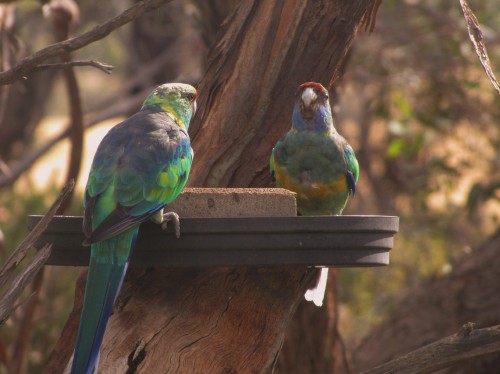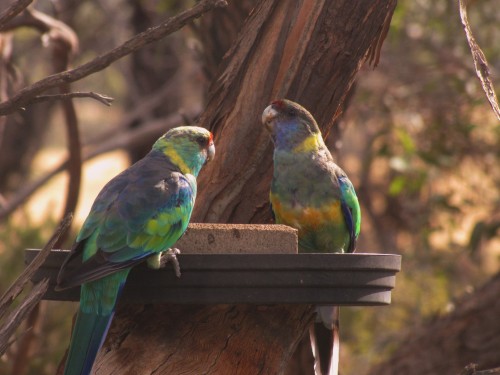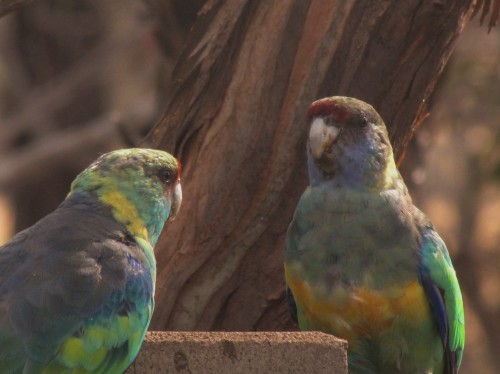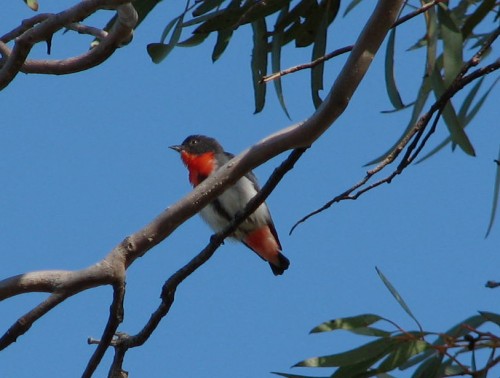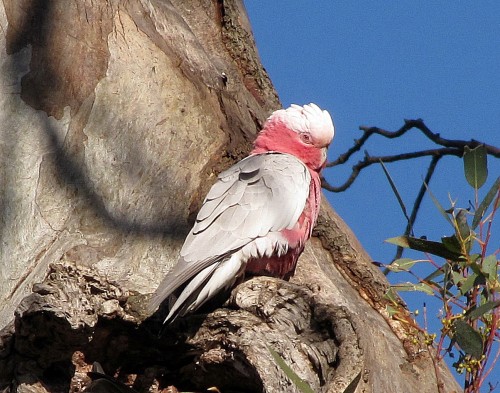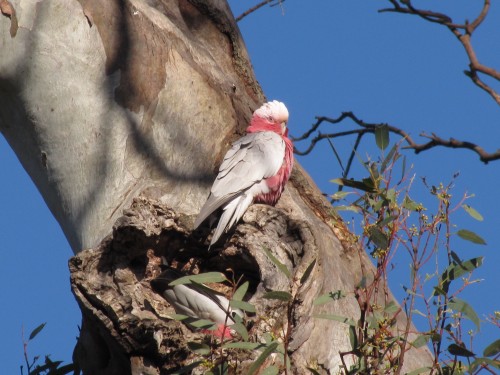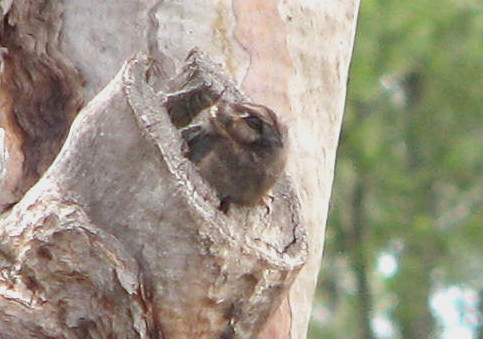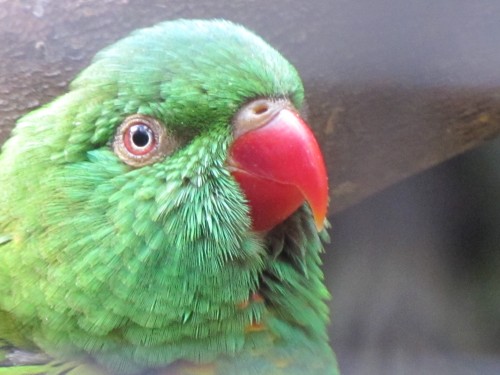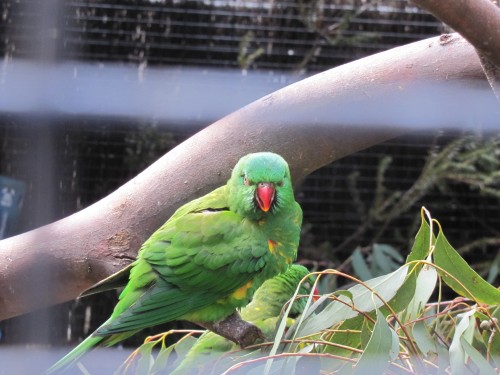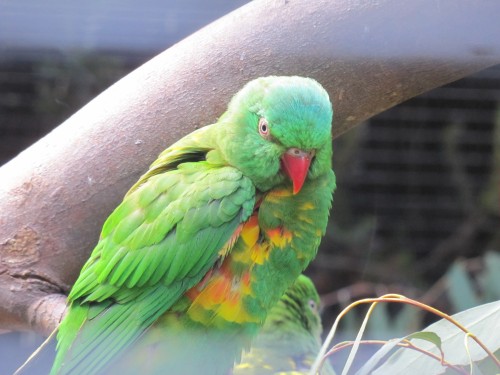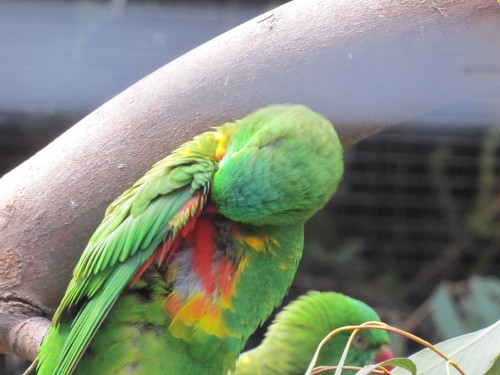Mallee Ringnecks on a hot day
During the hot weather we have experienced so far this summer here in South Australia I have had many opportunities to take photos of the constant parade of birds visiting our bird baths. We have positioned the water containers where we can see the birds from our sun room, a room we use often so we can enjoy the birds in our garden.
The Mallee Ringnecks shown in today’s set of photos are resident birds in our garden. This means that we see them every day. On several occasions in recent times they have raised a brood of young ones. We love seeing their colourful feathers as they fly around the garden and especially when they come to drink and bathe. At those times we can really get to appreciate their colours up close.
On the other hand, we have a love-hate relationship with these birds. We hate it when they get into our fruit trees, nibbling at the almost ripened fruit before we have a chance to rescue the fruits of our labours. This year, because of a bad back, I have not been able to cover the trees with netting. Consequently the birds – and possibly the resident possums as well – have taken some of our fruit. We were especially looking forward to a large crop of nectarines. (Those we were able to rescue were delicious.) I must get to the pears before the birds get to them as well.
Further reading:
- Ringnecks and kites
- Mallee Ringnecks nesting
- A small birding accident
- The beautiful Eastern Rosella parrot
A Mistletoebird pays a quick visit
Yesterday my wife and I were taking a short break from the jobs we had been doing. Sitting on our back veranda we were enjoying the lovely sunny spring weather we have had this week. It was afternoon tea time and we were enjoying a well deserved cup of tea. The back veranda has been a bit of a mess over the winter months and the weather has been too cold to spend too much time cleaning it up. Now that the spring weather is here we had a renewed enthusiasm for being outside.
While we sat there we enjoyed the constant parade of birds hopping around in the garden nearby. Many others were calling and we enjoy trying to identify them by call alone, a good way of honing one’s identification skills. Our resident Superb Fairy-wrens entertain us every day, as do the Mallee Ringneck parrots, the Eastern Rosellas and the Galahs. We can’t work out if the Galahs are actually nesting or not. The Spotted Turtledoves often join in the chorus and in recent days we have had the delight of Peaceful Doves also hanging around near the house.
As we sat there we were delighted to have a female Mistletoebird fly in and alight on a bush in full view just three metres from us. We were able to see the soft, dull grey colours of the feathers on her back, a stark contrast with the blue-black feathers of the male (see photo above). I didn’t have the camera handy, and the bird flew off after less than a minute, so I have shared a photo of the male taken some years ago. I do have one photo of the female, but unfortunately it is not in focus. Sigh.
I cannot categorically say that this is a resident species in our garden and on our 5 acre property, but it is certainly a regular visitor. I hear its call almost every week. Many years ago this was the first species to nest in one of the trees we planted after moving here. There may have been other species before it, but this was the first one we positively recorded doing this. The nest is a delicate pear-shaped container with a small entrance near the top. It is made primarily from spiders’ webs, small leaves, lichen and other soft materials, and hangs from small twigs or leaves. They are just coming into their breeding season, so I need to keep an eye open for a nest. This species is found throughout mainland Australia except in the driest regions. It is not present in Tasmania.
Further reading:
- Beautiful Mistletoebird
- Great Birding Moments #3
- If you click on the name of any of the bird species mentioned in the text above, you can go to other articles about that species.
A little night time visitor
Last night we were watching television with the lounge door open; it was a pleasant summer’s night. During a particularly quiet segment of the show we were watching we suddenly heard the churring call of our “resident” Australian Owlet-nightjar.
“He’s still around,’ we both cried out.
Now I need to clarify a few points here:
- I use the word “our” loosely. It is a wild bird in the natural environment so we do not own it.
- I am not sure if this particular bird is actually a resident on our 5 acre property. We do hear it often enough to think that it is here most days, but have no proof of that.
- I have no idea if it is a male or female – to call it “he” is more of a generic term.
Over recent months we have not heard this bird calling many times at all, so it was delightful to hear the call last night. I like to think that it is quite contented living around here most of the time.
A few years ago one bird – perhaps the same one – took up occupation of a significant hollow in one of our mallee trees in our back yard. Amusingly, during the cool winter months it would emerge from the hollow every morning around 11am and sun itself in the opening of the hollow, call a few times and then retreat to sleep until evening. Sometimes we would even hear it calling again as it went out feeding during the night., being mostly a nocturnal species. It was on one of those occasions that I was able to sneak up closer for a photo (shown above).
Over the last two summers the hollow has come under the “ownership” of a pair of Mallee Ringneck parrots who have successfully added to their family each time. Lately they have been busy feeding two very persistent young ones which have recently fledged.
Further reading:
- Australian Owlet-nightjar
- Australian Owlet-nightjar
- Australian Owlet-nightjar does exist
- Australian Owlet-nightjar in our garden
- A special call in the night
It that close enough for you?
This Scaly-breasted Lorikeet in one of the aviaries at the Australian Reptile Park made certain I managed a good photo of it up close. He posed in a number of different ways, squawking loudly as if to ask how it looked.
It is getting photos like this one that I like visiting zoos, and especially zoos with aviaries. While it is great if the zoo has walk-through aviaries, I have proved that one can take reasonable shots through the wires of the cage. Sometimes you just get lucky – like on this occasion – and the bird poses really well.
Scaly-breasted Lorikeets are found along the coastal regions of eastern Queensland and in north-east New South Wales. It is a species I have yet to observe in its natural environment – another reason for getting photos in a zoo. I think I am well overdue for a trip to Queensland.

